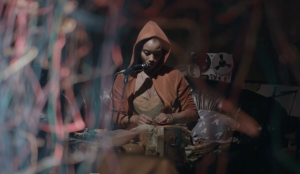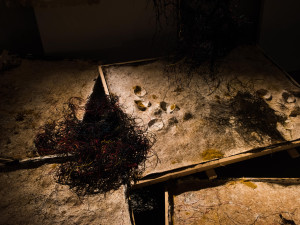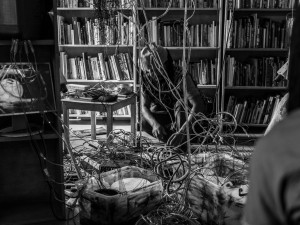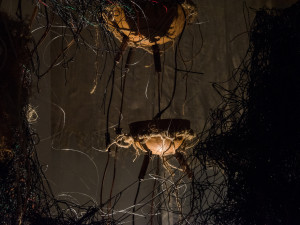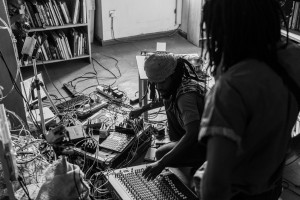
Online
Fortnightly Highlight 11: Sǒ bàtú — To bathe one’s ears
–
Dear friends,
What is the aesthetic of the ritual?
Last October, The Showroom hosted Tahjèsè #3i / barɨŋ báchɔ́kɔrɔk #4 an immersive, multifaceted environment created by artist Em’kal Eyongakpa. Organic, electronic networks and acousmatic rhythms interwove in an evolving soundscape, in which the drumming echo of water dripping onto self-made instruments reverberated through the walls of our building, transforming it into a shrine of ancestral beliefs; a vessel of intergenerational vernacular knowledges, in which creatures in the form of entangled sculptural strands of plant fibre, low-tech wiring devices and high-tech sonic interfaces produced a mode of storytelling that, if listening closely, would have brought the visitor to another time and place.
For those willing to give it their time and soul, the work, which took shape as a conceptual art installation, constituted a space of reflection and wonder; a portal to a different realm. Drawing from mechanisms of ritualistic imaginaries and stories known to those familiar with the indigenous cultures of Southwest Cameroon, the work was an invitation to bathe one’s ears with the sonority of both the unknown and the quotidian. At a deeper level, the piece was an allure, a sort of initiation into an aesthetic experience, formulated as a space of resistance to the imminence of the present, in which something else about the self and the world could be revealed.
It was also a reminder of the futility of wars, like the one in which this area of the world has been engaged since 2017 – known to the public as the Ambazonia War or the Anglophone crisis – the lives lost, the villages looted, the anguish of communities subdued. A poignant reminder of the aftermaths of unresolved colonial divisions and borders, such as is the case of the Mungo border between former Southern Cameroons and French Cameroon after the defeat of Germany in World War One.
These histories and their consequences are a source of Eyongakpa’s artistic and aesthetic experiences; a practice that encompasses numerous preoccupations, including a questioning of cultural identity, the formulation of communal and individual agency, the recovery of indigenous sonic power and instruments, environmental awareness, and the acknowledgement of the role in our lives of what he names non-human collaborators.
This special edition of our Fortnightly Highlights follows aspects of Eyongakpa’s body of work and its evolving nature, not only as an artwork – which we follow here from his studio in Biljmer, Amsterdam, to the streets of Lagos in a recent collaboration with the Centre for Contemporary Art, Lagos and Kadist – but also as the formulation of a new cultural setting in the absence of institutional frameworks that could host and support his existential queries; an experimental collective space that he opens up to artists, musicians, poets and other practitioners; and most recently to azura pataku, whose work we feature in this edition.
Each Fortnightly Highlight involves a deeply collaborative process, rich in exchange and opportunities. To every one of them, our colleague Elliot Anderson brings an attentive, innovative spirit. Thank you, Elliot. This edition would not have been possible without the care and rigour that distinguishes Assistant Curator Lily Hall’s approach to curation. Our curatorial dialogue with Eyongakpa has continued since the show, and it provides the content that both the artist and Hall sign below.
Lastly, I would like to dedicate this Fortnightly Highlight to our late beloved friend, CCA Lagos Founding Director Bisi Silva, whose wisdom and labour of love felt intensely present in Eyongakpa’s kɛrakaraka #3-i / mɔ́ ntaï bɛrrɛ rendition in Lagos.
I invite you to challenge yourself into taking this journey. One that, as with all rituals, demands of us a subjective approach and a total commitment of our being. A pure embodiment.
Warmly,
E
Elvira Dyangani Ose
Director, The Showroom
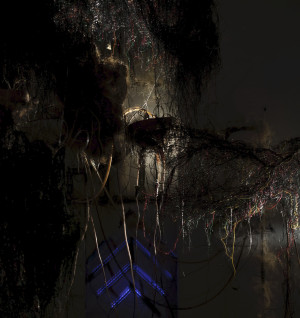
EXHIBITION
In 2019 The Showroom presented Tahjèsè ## 3i / barɨŋ báchɔ́kɔrɔk #4, an immersive sculptural environment and the first solo commission in the UK by Em’kal Eyongakpa. The installation forms part of an ongoing body of work for Eyongakpa titled sǒ bàtú (2016-), which includes live sonic sketches, processions and kinetic sound sculptures through which he evokes portals, crossings and the role of water in relation to resistance movements from the oil and natural gas-rich region of the Gulf of Guinea and beyond.
In Kɛnyaŋ, a language widely spoken in the Cross river basin in Northwest Cameroon, ‘sǒ’ translates as to bathe or to cleanse and ‘sǒ bàtú’ is to bathe one’s ears, or ear bath. The exhibition’s title has multiple readings, also drawn from indigenous aesthetics recurrent in the Manyu region, where the Cross and Manyu rivers converge.
‘Tahjèsè’ is a site in Eshobi, close to the confluence of the river Manyu, and is believed to be the site of a portal from where ‘barem’ (ancestral spirits) emerge to chant, luring people into long, unconscious states. ‘barɨŋ’ translates as veins, and ‘báchɔ́kɔrɔk’ as clock birds; so ‘barɨŋ báchɔ́kɔrɔk’ literally means veins of clock birds. These associations informed Eyongakpa’s water-based sound sculptures or ‘rhythm generators’ at The Showroom, for sǒ bàtú reflections.
WATCH: two new video clips of Em’kal Eyongakpa’s immersive kinetic installation, with fragments of the accompanying soundscape, together with images of the total environment at The Showroom, 2019
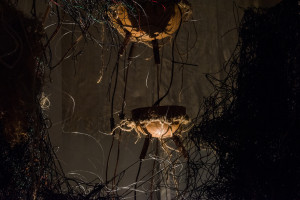
Water culture; water culture
Multicultural melting pot.
Changing hats and different tongues
Scores of a long-forgotten clan.
Cross River. Crossing rivers
Products crossing waterways.
Cross River. Crossing rivers
Cross River cosmology.
Across the border. All in order
Water culture; water culture
Multicultural melting pot…
— Em’kal Eyongakpa
In a holistic extension of the core ideas, shrine-environment and sculptural-sonic materials used within Tahjèsè ## 3i / barɨŋ báchɔ́kɔrɔk #4 at The Showroom, Eyongakpa has continued developing these sound sculptures and polyrhythmic beat generators at his studio in Amsterdam. Assemblages of entangled sculptural, analog and electronic elements form a new live interface, which he names Kerakaraka +1i / e-Mungo West #7. This relies on the weather and the elements to create atmospheric environmental acoustics, as well as water and oil-run polyrhythm generators, and customised woodwind instruments.
For Eyongakpa the semi-enclosed space created by this sculptural/sonic environment becomes a shrine within which he continues to explore ever-new solo and collaborative improvisations in which to reflect, intercede and share sonic dialogues.
WATCH: Em’kal Eyongakpa’s inter-session with Magdalena Akua Agyekum, recorded at mɔ ntaï tabindɛ, an analog studio and sound sculpture within Bɔ́ Bɛtɔk Bijlmer, Amsterdam, in August 2020.
This intimate video, recorded by a fixed camera, documents an initial conversation between Em’kal Eyongakpa and Magdalena Akua Agyekum within mɔ ntaï tabindɛ, which led to her subsequent residency in Amsterdam.
“So…drops like these make up rivers, and you decide where we stop the beat. We make a rhythm machine. And we tell a story. And so we see what happens…”
— Em’kal Eyongakpa with Magdalena Akua Agyekum
In a durational, spontaneous exchange, Em’kal experiments with kerakaraka +1/ eMungo West ## 7 whilst having a conversation with Magdalena; an improvised call-and-response. Using his analogue polyrhythm machine, dripping water is accompanied by an array of adapted indigenous, percussive and wind instruments from the Cross river basin in the Cameroons and beyond. Em’kal and Magdalena create textures and rhythms against irregular beats, creating counter points that provide a backdrop for their poetic, intuitive storytelling.
The 45 minute sequence was shot prior to Magdalena Akua Agyekum / azura pataku’s residency, The water hit me, in August 2020.
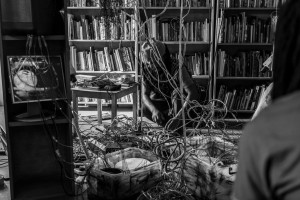
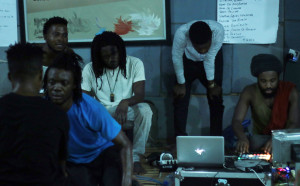
In January 2020, Em’kal developed a new project and installation titled kɛrakaraka ## 3-i / mɔ́ ntai bɛrrɛ as a commissioned intervention within the larger group exhibition Diaspora at Home at CCA Lagos, in partnership with Kadist, Paris.
Over the course of two days he delivered a series of sonic lectures and live sets. In this context, the work took shape as an installation of three ‘six-veined’ sound sculptures, titled kɛrakaraka ## 3-i, which include analog polyrhythm generators developed over the last couple of years and during Tahjèsè #3i / barɨŋ báchɔ́kɔrɔk #4 at The Showroom. These interacted with fragments from mɔ́ ntai bɛrrɛ, together forming a new multi-channel sound installation.
WATCH: Em’kal Eyongakpa, kɛrakaraka ## 3-i / mɔ́ ntai bɛrrɛ (excerpt). Day one of sonic lectures and live sets or ‘inter-sessions’ within the installation at CCA Lagos Library, 30 January 2020. Video footage courtesy of Kene Nwatu
LISTEN: to a recording of a collective inter-session devised by Em’kal with a group of collaborators, building upon their presence at the series of sonic lectures and live sets held at CCA Lagos Library. With with Jere Ikongio, Busayo Olowo, Soft Mix, Jibril Adewumi Africanana and Joshua Akubo
READ: scroll down for a fuller explanation of how Eyongakpa’s sculptural instruments are assembled and function as part of his wider installations
